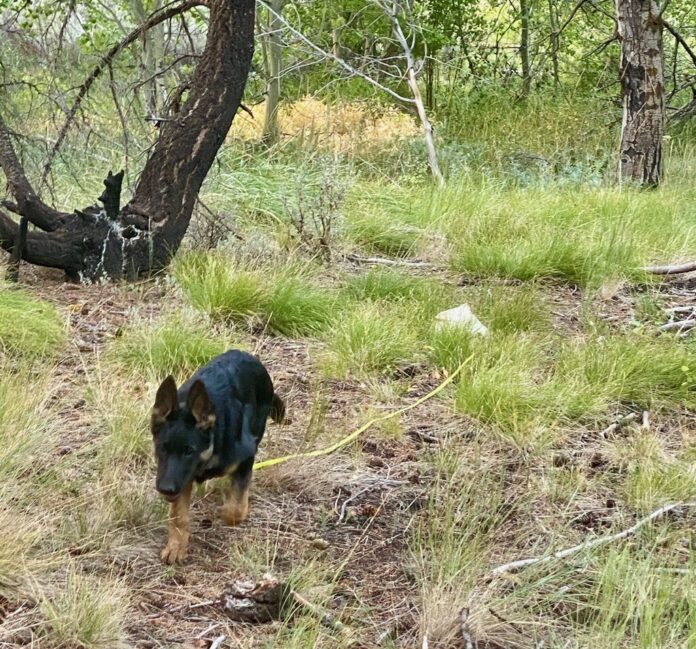
By Fran Jewell
It is of HUGE importance that puppies remain on a leash until they have a flawless recall. In puppy development, almost all puppies are preprogrammed by Mother Nature to follow the leader until they are approximately 19 weeks old. That can lure us into believing they have learned how to come when they are called. However, at this critical time of 19 weeks or so, they begin to feel confident and will start to look at you as if to flip you the paw! “I’m busy sniffing over here; I’ll come when I want to!” If our puppies have been given the freedom to be off leash when out of a confined area, this can become a life-threatening situation.
I see many people taking this to heart and keeping their puppies on a leash for walks, usually a short leash of about 6 feet, or a Flexi. While I am filled with gratitude that people are keeping their puppy on a leash, it is also important to realize that puppies asked to heel at a young age become very frustrated and will bite at the leash, pull hard on your clothing, bite you, or start barking at anything. Puppies need to explore their environment to be satisfied mentally and physically. Teaching short-leash walking takes knowledge, patience and LOTS of time before expecting a puppy to go any distance.
So, how do we keep a puppy from becoming overloaded by frustration and beginning to develop horrible leash habits? I think a long line of about 20 – 30 feet long, depending on the size of your dog, is the solution. Yes, it can be very difficult to walk a puppy on a sidewalk, bike path or foot trail on a long leash. Because of that, many people will not use the long leash. A long leash can drive many people insane trying to keep it rolled up so it doesn’t drag on the ground. There is technique to learn as well so YOU don’t become too frustrated! The KIND of long line you have can help. I use “biothane” leashes that slide through the sage, and can be easily washed when dirty. They are not hard to hold when they are wet, either.
There are many things you can do with the long line. Start by finding an open space to walk in. I do NOT suggest the dog park for a plethora of reasons at this early age. But, there are many, MANY open areas or old dirt roads that work wonderfully. This gives your puppy a chance to explore his environment, sniff, run, and bark in safety. It also gives you the opportunity to practice “come” whenever the long line is taut, then rewarding your puppy for quick returns. It allows the puppy to learn where the end of the leash is without pulling you over and creating that adversarial position between you, the puppy and the leash. When the puppy comes near you on either side, offering a treat for that behavior can be the beginning of teaching him to walk nicely next to you without pulling. If done correctly, the puppy will never learn to pull on a short leash.
Think of walking nicely on a short leash as being similar to learning something in high school, when your pup is still in elementary school. Set your pup up for success by not asking for too much too soon and understanding what he needs to learn and CAN learn at an early age. Unless you are a full-time dog trainer, it can be very difficult to teach a young pup to walk on a loose short leash too early.
Keep your puppy safe on a leash, but make it a 30-foot-long line instead of a short leash. Help him to explore and learn in a guided fashion. The both of you will enjoy each other so much more!
Fran Jewell is an IAABC Certified Dog Behavior Consultant, NADOI Certified Instructor and the owner of Positive Puppy Dog Training, LLC in Sun Valley. For more information, visit positivepuppy.com or call 208-578-1565.
